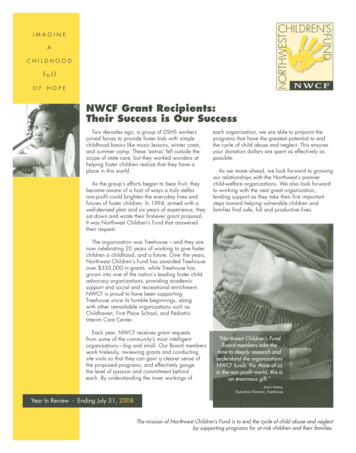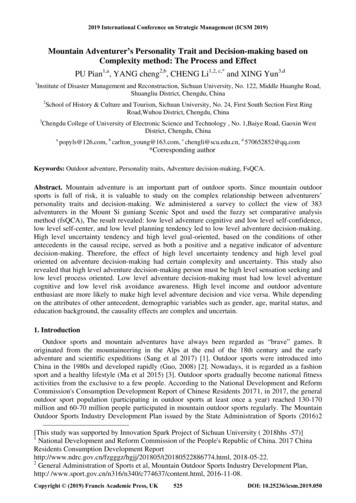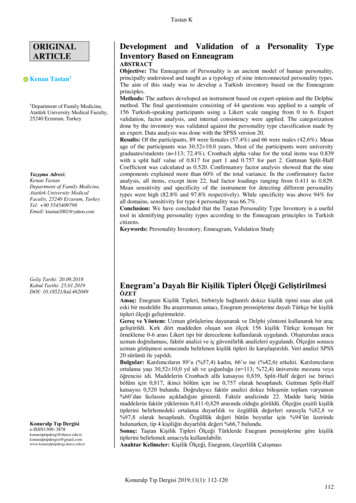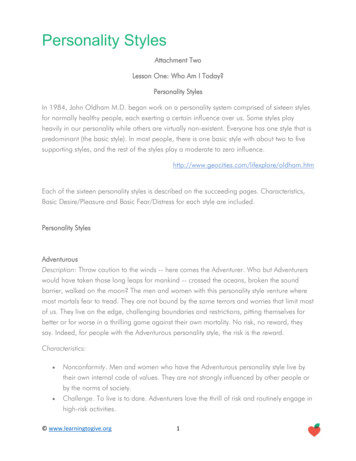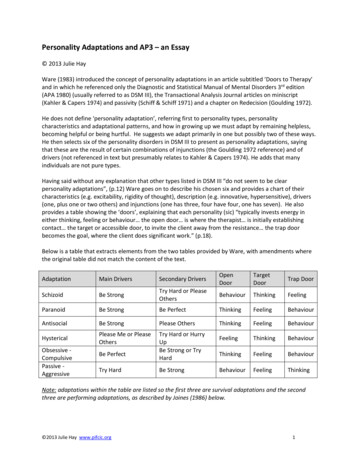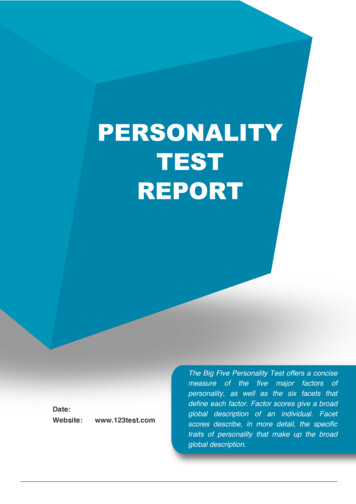
Transcription
Communication Success withFour Personality TypesSecond EditionPreston Ni, M.S.B.A.Professor of Communication Studieswww.nipreston.com/home
2Also by Preston C. NiHow to Communicate Effectively and Handle Difficult People, 2nd EditionTen Tips to Presentation Confidence and Reducing NervousnessBridging Cultural Communication Differences: East and WestCross-Cultural Communication: East and West (DVD/Video)With Dignity and HonorUnderstanding Racism, Unlearning Racism, 2nd EditionFor more information or to purchase, visit www.nipreston.com/homeProf. Ni is available as a presenter, workshop instructor, course designer, andpersonal coach. For more information, write to commsuccess@nipreston.com, orvisit www.nipreston.com/homeCopyright 2007 Preston C. Ni.All rights reserved worldwide. No part of this manual/article shall be reproduced in any formwhatsoever, stored in a retrieval system, broadcasted, transmitted, or translated into any kind oflanguage, in any form or by any means, electronic, mechanical, photocopying, recording, orotherwise, without the express prior written permission from the author.No responsibility for the loss occasioned to any person acting or refraining from action as a resultof the material in this publication can be accepted by the author or publisher.No patent liability is assumed with respect to the use of the information contained herein. Theauthor and publisher assume no responsibility for errors or omissions. Neither is any liabilityassumed for damages resulting from the use of information contained herein.
3ContentsIntroduction4The Four Personality Types5Relater-Supporters6Communication Success with tion Success with unication Success with n Success with Driver-LeadersReferences16
4IntroductionWhat is human behavior? In what ways are we similar and different? How can wesuccessfully communicate with one another?This article, in part, is an interpretation of the well known Myers-Briggs Type Indicator.This and similar tests are now used by many organizations in hiring, professionaldevelopment, and performance evaluation. The tests are available on the web as well asin print (see references). The purpose of this article is to present an overview of fourmajor personality types, identify their strengths and challenges, and provide informationon how to communicate more effectively with each type as family, friends, colleagues,and customers.Please keep these two cautions in mind as you read this article:First, this information is for reference only. There’s always a risk with personality testsof sorting people into boxes. Even when a person clearly matches one personality type,not everything written about that type may match the person. We’re far too complicatedto fit neatly into broad categories.Second, most of us have a dominant personality type, with one or two secondary types.These traits can change and evolve over time.As Buddha once said, “A finger pointing at the moon is not the moon itself. Anintelligent person makes use of the finger to see the moon.” There are many ways to helpachieve greater human understanding and communication success. The informationpresented in this article may point to one.
5The Four Personality TypesThe four personality types are: Relater-Supporter, Initiator-Cheerleader, AnalyzerInvestigator, and Driver-Leader.It’s generally not too difficult to identify the primary personality type of an individual,based on his or her persona, communication style, and to some extent profession.Here are some of the most dominant traits of each type:Relater-Supporters tend to be “nice”, supportive, nurturing, and friendly.Initiator-Cheerleaders tend to be energetic, motivating, persuasive, and fun.Analyzer-Investigators tend to be detail oriented, task driven, analytical, and matter-offact.Driver-Leaders tend to be powerful, achievement conscious, control oriented, andproductive.While the dominant personality type of most individuals tends to be fairly easy toobserve, the secondary personality type (or types) tends to take some knowing of aperson to deduce. Most people have one dominant, one or two secondary, and oneweakest type. The following pages describe each personality type in detail, includingstrengths and challenges, relationships with other types, and communication strategieswith each type as family, friends, co-workers, and customers.
6Relater-SupportersCommon Professions: People-oriented and service professions, such as nursing,counseling, executive assistant, and customer service.TraitsNurturer, sociable, value interpersonal relationships and are more subjective in decisionmaking. Their conduct is often based on values and intuition. They are emotionoriented, persuasive, take care of others and are romantic introverts.ChallengesPersonal feelings can get in the way of objectivity. They can be too passive, can’t say“No” and are conflict avoidant. They take care of the self last and make sacrifices forothers at the expense of the self.Relationship with Other TypesInitiator positive: Admire Initiators, want their energy to rub-off and want to be part ofthe fun.Initiator negative: Overwhelmed by the high energy of the Initiator.Analyzer positive: Glad capable Analyzer can handle details of the task.Analyzer negative: Think of the Analyzer as cerebral, cold, impersonal and lackinghuman sensitivity and consideration.Driver positive: Feel supported by the “people person” Driver.Driver negative: Find the Driver intimidating and domineering.Core Needs: Relater-Supporters want to be liked, accepted, and loved.Validating Core Needs: As genuine and appropriate, remind Relater-Supporters on aregular basis how much you appreciate who they are, what they do, and the quality of therelationship.In Summary: For a Relater-Supporter, a day without a smile, kind words, andfriendliness from others is like a flower without air, sunshine, and water. The flower willwilt, just as the Relater’s heart will grieve. Love and appreciate a Relater-Supporter, andthe Relater-Supporter will love and appreciate you back ten-fold.
7Communication Success with Relater-SupportersKey: Validate Relater-Supporters’ Core Needs - To be liked, accepted, and loved.In daily interactions, stress acceptance of the person and quality of the relationship.Consider applying the following if you’re genuine in your intentions:With Relater-Supporter Family Members or Friends: Remind them often how much you value them in your life, and how important therelationship is to you.Don’t wait for Relater-Supporters to ask for help, as they rarely will. Whenappropriate, see what they need, and help them without asking. Relaters can bevery touched by this, for they feel they have found that rare individual whounderstands at least some of their often unspoken needs.Do or give something special to pamper them. For they tend not to pamperthemselves, and will really appreciate the gesture when someone thinks of them.As Co-Workers: Show appreciation for all that they do for others.Mention how much you appreciate them as colleagues.Ask if they feel okay about their role in a group or task.As Customers: Let them know you value your relationship with them as customers.Stress how your products or service can help the ones they love, and contribute totheir happiness and/or well-being.Emphasize personal, one-on-one service. Mention how they’ll be taken good careof as your special customers.In Problem Solving and Relationship Challenges: When challenges arise, stress that the issue does not affect the quality of therelationship. Let them know that you value the relationship, and at the same timethe issue needs to be resolved. Let them know how much you appreciate their willingness to problem-solve withyou. Thank them warmly and show appreciation when they show support,compromise, or sacrifice. Be sure to let them know that you notice their efforts.
There’s more to this excerpt!Get the whole article at www.nipreston.com.Boost your communication success at www.nipreston.com with information on:— Free resources, articles, and tips— Private coaching and organizational training— College courses— Public workshops— Information on other books, DVDs, and publications by Preston NiQuestions and comments? E-mail commsuccess@nipreston.comP reston N i communication coaching
While the dominant personality type of most individuals tends to be fairly easy to observe, the secondary personality type (or types) tends to take some knowing of a person to deduce. Most people have one dominant, one or two secondary, and one weakest type. The following pages describe each personality type in detail, including strengths and challenges, relationships with other types, and .


